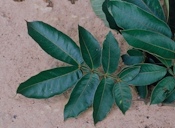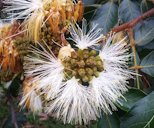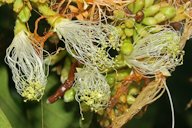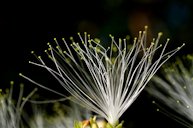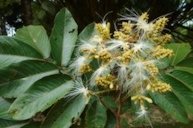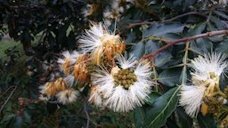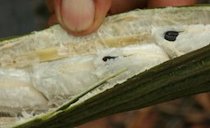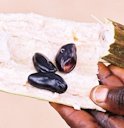| Ice Cream Bean - Inga edulis | |||||||||||||||||||||||||
|---|---|---|---|---|---|---|---|---|---|---|---|---|---|---|---|---|---|---|---|---|---|---|---|---|---|
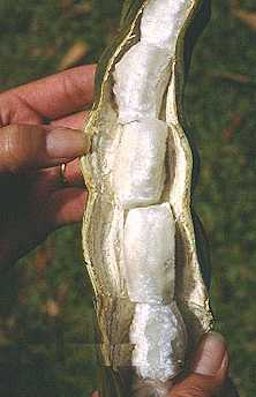 Fig. 1 Inga edulis. Detail of opened pod displaying its content of sweet, fleshy, translucent pulp that is eaten by people in Brazil, Ecuador, Peru and Costa Rica. 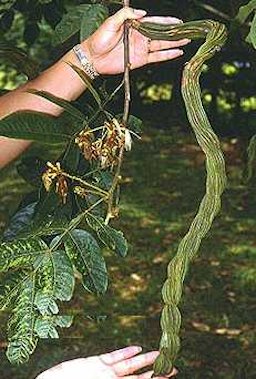 Fig. 2 I. edulis. Detail of pod and leaves 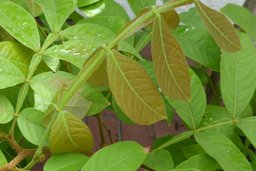 Fig. 3  New growth is reddish 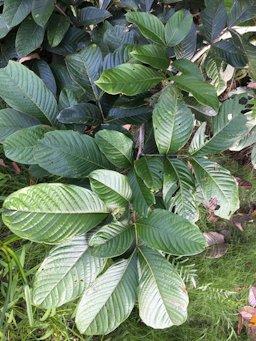 Fig. 4   Fig. 5  The rachis are winged with 4-6 pairs of subsessile (having no stalk) leaflets 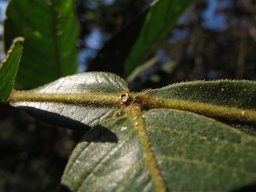 Fig. 6  The leaflets are minutely pubescent on both surfaces 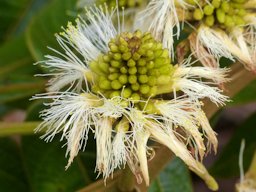 Fig. 11  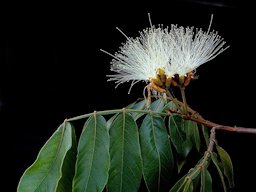 Fig. 12  I. edulis Mart. Fabaceae. Campus da UnB, Brasília, Brasil. 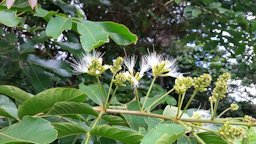 Fig. 13  I. edulis, Ho'omaluhia Botanical Garden, Oahu, Hawai'i Fig. 14  Inga sp. Ecuador 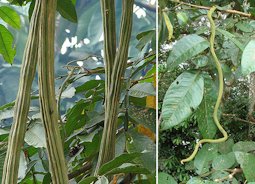 Fig. 20  I. edulis, mature and juvenile guama pods. The ice cream bean in its native Amazon basin, Columbia. 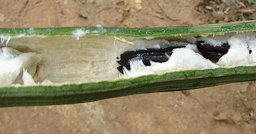 Fig. 21  Amazon Ice Cream is the sweet, white pulp in the pods of the Guama tree. Widely planted from northwestern Amazon Basin and also appreciated for timber and folk medicine. 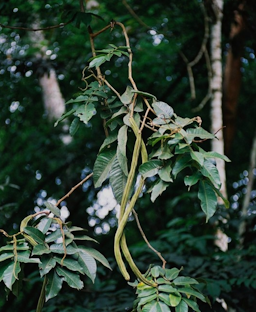 Fig. 22  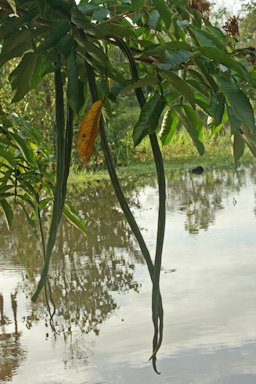 Fig. 23  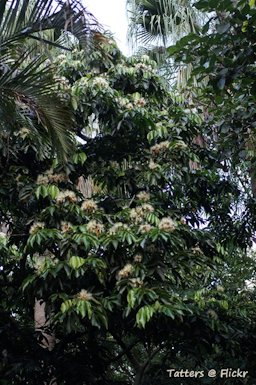 Fig. 27  I. edulis tree 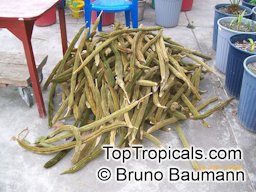 Fig. 28  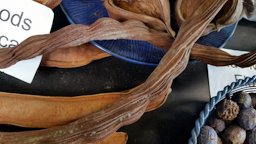 Fig. 29  Inga pods. The one in front with all the ridges is I. edulis. Both are ice cream bean, and they can be viviparous (can sprout in the pods). 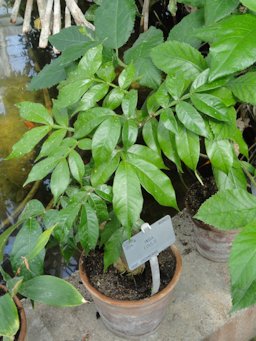 Fig. 30  Young plant growing in the University of Copenhagen Botanical Garden, Copenhagen, Denmark 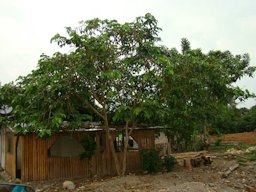 Fig. 31  I. edulis Mart., Peru 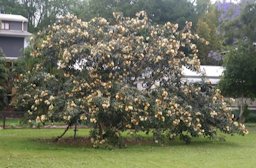 Fig. 32 Ice cream bean tree flowering (I. edulis) in the local park. Brisbane, Australia. 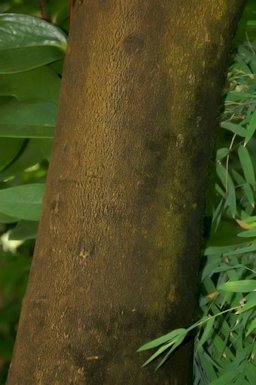 Fig. 33  I. edulis Mart., New York Botanical Garden 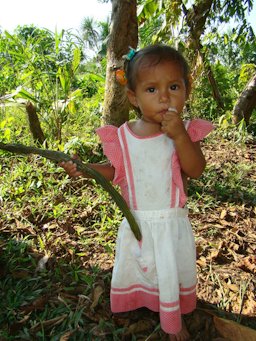 Fig. 34  |
Scientific
name Inga edulis Mart Common names English: ice-cream-bean; Spanish: chalaite, cuajiniquil, guaba, pacay; Argentina: ingaguazu ("great"); Bolivia: inga de macao; Brazil: abaremotemo; abavemo; engá; ingá; ingá; ingá cipó; ingá doce; ingá macarrao; ingá timbo; ingá-caixao; ingá-cipó; ingá-da-beirada; ingá-da-praia; ingá-doce; ingaí; ingá-opeapiíba; ingá-rabo-de-mico; ingá-timbó; ingá-verdadeira; rabo de mico; rabo-de-mico; Colombia: inga, rabo de mica ("monkey tail"), guamo, guama; Costa Rica: guaba chilillo; monkey tail; Equador: barisa pacae; estihus pacae; French Guiana: pois sucré ("sweet pea"); Guyana: waikey; Martinique: pois doux ("tender/sweet pea"); Peru: guabilla, pacae soga, pacay, rujino shimbillo, waupa; Panama: guava machek; Venezuela: guamo bejuco ("liana"), guama; West Indies: ice cream bean 6,7 Synonyms Feuilleea edulis (Mart.) Kuntze 5 Relatives Inga-acu, I. cinnamomea; I. capitata, I. velutina, I. macrophylla, I. alba; carob, Ceratonia siliqua; tamarind, Tamarindus indica; Guamuchil, Pithecellobium dulce 6,11 Family Fabaceae⁄Leguminosae (pea family) Origin Native to South America USDA hardiness zones 9b-11 Uses Food/beverage; food additive; fuel; animal feed; shade; living fence Height Up to 130 ft (40 m) in native climate Crown Broad, flat, moderately dense canopy; much branched crown often as wide as the height 1,22 Plant habit Evergreen; branching 3.3-6.6 ft (1-2 m) from base 3 Growth rate Rapid Longevity Long life, 30-50 years 24 Trunk/bark/branches Contorted trunk; bark pale grey, smooth with pale elongated lenticels; twigs angular in cross-section; covered with fine short hairs 1 Pruning requirement Can be severely pruned after 4 years in the ground to maintain a low canopy 11 Leaves Once-pinnate; up to 9.5 in. (24 cm) long; 4-6 pairs of opposite leaflets 1 Flowers Whitish; scented; sessile; bunched at the end of the rachis; calyx and corolla with about 80 stamens 6 Fruit Ribbed, cylindrical pods; straight or often spirally twisted; up to 3.3 ft (1 m) long; fleshy green seeds in a sweet, white, cottony pulp 1 Season Trees can flower and fruit all year round Light requirement Full sun Soil tolerances Particularly tolerant to acid and poor soils 1 pH preference 5-6.5, tolerating 4.5-8 9 Drought tolerance Remarkably resistant to drought 1 Soil salt tolerance Low salt tolerance 11 Cold tolerance Young plants killed at 32 °F (0 °C), older plants survive to 25 °F (-3.8 °C) 11 Roots Nitrogen-fixing 11 Invasive potential * None reported Pest resistance Apart from slight damage from fungal attack, tree seems very resistant to diseases and pests 1 Known hazard Unknown Reading Material Inga edulis, Agroforestree Database Inga edulis Mart., Handbook of Energy Crops The Ingas of the Brazilian Amazon, Archives of the Rare Fruit Council of Australia Inga edulis, Food and Agriculture Organization of the United Nations Origin/Distribution Inga edulis is native to South America – Amazonian Brazil, Bolivia, Peru, Ecuador, Colombia, Venezuela, Guyana, Surinam and French Guiana. The species has been introduced across most of tropical South America, Central America – Panama, Mexico and Costa Rica, northern Australia and Tanzania. 21 Description The genus Inga, Leguminosae (Mimosoideae), is represented by approximately 180 species in the Brazilian Amazon, and of this number, there are but a handful of 4 to 5 species having any appreciable quality as edible, fresh fruit. Without question, first place goes to "ingá cipó" (Inga edulis), significantly improved through cultivation. 6 Inga edulis mature trees reach 30-40 m high and 60 cm diameter at breast height, usually branching from below 3 m. The branches form a broad, flat, moderately dense canopy. The bark is pale grey and smooth with pale elongated lenticels. The young twigs are angular in cross-section and covered with fine short hairs (Fig. 6). 1 The edible fruit is very popular in South America, where it is commonly gathered from the wild and also often cultivated. The fruits are often sold in local markets. 8 Trees extensively used in Central and South America for shade for cacao, coffee, tea and vanilla, especially at lower altitudes, and for parks, avenues, and watershed preservation. The species is reported to have nitrogen fixing nodules. 3 It also has mycorrhizae in its roots which play an important role in enabling the tree to take up phosphorus even though phosphorus is in very short supply in acid soils. 21 Leaves Leaves, once-pinnate, up to 24 cm long, with 4-6 pairs of opposite leaflets, minutely pubescent on both surfaces (Fig. 6). The terminal pair of leaflets is larger than the basal pair and can be up to 18 cm long and 11 cm wide. Between each leaflet there is a nectary gland on the winged rachis (Fig. 6,8). The seedlings have a characteristic greyish sheen on the upper leaf surface. 1,3 It is known that Inga species are in symbiosis with ants (eg. Pheidoles spp.), which get the nectar of the extrafloral nectaries. In exchange the ants will patrol over the Inga plant to protect it against herbivores. There are certain insects such as Riodinid caterpillars which excrete sugary honeydew from their tentacle nectaries. The ants will form a symbiosis with the caterpillars by letting them feed on the tree and in favour of getting sugary honeydew from them. 15
Fig. 7. The terminal pair of leaflets is larger than the basal pair Fig. 8. Between each leaflet there is a nectary gland on the leaf rachis Fig. 9. I. edulis, abaxial view of leaf Fig. 10. Close-up of winged rachis, Brisbane, Australia Flowers Inflorescence in dense axillary spikes of flowers, each consisting of a calyx tube with 5 lobes, a corolla tube with 5 lobes, and a large number of white stamens up to 4.5 cm long, united in a tube in the lower half. 1 In humid climates I. edulis may flower throughout the year, but in regions with a short dry season it is most likely to flower at the beginning of the wet season. The inflorescences may not have many flowers open at the same time, but they are usually conspicuous. 2 They only open for one night and wither very quickly in the early morning. Like many other nocturnal flowers, they are large, white in colour and arranged in dense clusters (inflorescences). 13
Fig. 15. Close-up of I. edulis flower, Brisbane, Australia Fig. 17. I. edulis, ingá-cipó Fig. 18. I. edulis Mart., inflorescence with leaves Fig. 19. Ice cream bean tree flowering (I. edulis) in the local park, Brisbane, Australia Fruit The fruit is a cylindrical pod, with many furrows along its length, olive green, from 19-60 in. (50-100 cm) long, exceptionally to 3-5 ft (a meter and a half). The exocarp is woody, and does not open spontaneously, with oblong seeds up to 1.4 in. (3.5 cm) long, and made up of two thick, shiny black cotyledons, the membranous testa dressed in white pulp (aril) which is soft, slightly fibrous and sweet tasting. 5 The pulp surrounding the seeds in the seedpod is white, translucent and moist with a sweet, perfumed flavour. Much esteemed in Ecuador, some forms have a slight cinnamon flavour. 10 Fruit set requires that more than one genetically different tree be in the same vicinity. This is why solitary ornamental trees normally fail to set fruit. 4
Would the real Inga edulis please stand up, Rare Fruit Club WA Varieties Lightly cinnamon flavoured varieties have been noted and these are considerably more attractive. 18 Harvesting Flowering and fruiting 2-3 times every year, at different times on different trees; the ripe pods take 3 months to develop. Pods are either pulled off lower, or cut off higher branches when thick and soft. They may also yellow slightly at this stage. Pods will keep for almost a week after harvest and are easily carried. A tree with a 10 m crown will produce 20 to 100 pods at least twice a year. 18 No great amount of fruit is harvested at once. 3 Pollination Flowers of this type are typically pollinated by bats. Their furry faces get powdered with pollen as they search for nectar at the base of the flower. Recent research into Inga has shown that at least in some species (e.g. Inga sessilis), hummingbirds are the first visitors just after the flowers open, followed by bats as well as hawkmoths throughout the night. 13 Propagation The seeds are recalcitrant and sometimes begin to germinate in the pod, often within a few days of reaching the ground, where they need moisture to survive. The seeds can be stored for only 2 weeks. Best results have been achieved by removing the pulp and storing the seed in impermeable bags. 1 Seed is best sown as soon as it is ripe. Sow in a lightly shaded position in a nursery seedbed. A high rate of germination can be expected, with the seeds sprouting within a few days. Transplant the seedlings to individual containers when they have 4-6 leaves and they should be ready for planting out 4-5 months later. 8 Amazonian farmers prefer trees that produce deep black seeds (which they call 'female') over lightly coloured ones (called 'male') as the former are more productive. Some varieties produce polyembryonic seeds. 19 Inga edulis has not been reproduced by cuttings. 2 Planting Prefers a sunny position, but also succeeds in dappled shade. Tolerant of a range of soil conditions, including limestone. It can succeed on floodplains that are waterlogged for 2-3 months each year, and is also remarkably resistant to drought, occurring in regions with a 6-month dry season. Prefers a pH in the range 5-6.5, tolerating 4.5-8. 9 The distance between rows of plants normally is 4 meters and between plants in the row, 50 to 100 centimeters. 23 Requires a tropical climate with plenty of moisture. 3 Inga Alley Cropping Manual, Rainforest Saver Pruning I. edulis grows back well after pruning, but not if cut below 0.75 m. There is a better response if pruning height is varied and a few branches are left uncut. The cut should be made carefully, at least 3 cm above a node from which the shoots can grow again. 1 Pests/Diseases Although the trees are resistant to leaf-cutting ants, Lepidoptera larvae have been seen to completely defoliate it. Fruit fly larvae often damage the seed testa, especially in late maturity. Slight damage from fungal attack (Rhizoctonia) of seedlings has been noticed; otherwise the trees seem very resistant to diseases and pests. 1 Food Uses Plants cultivated for the edible white pulp of the fruits, are eaten out of hand or used in flavoring various desserts. Ice Cream beans complement all the flavors typically paired with vanilla. The pulp may be combined with chocolate, coffee, cream, custard, almonds, allspice, cardamom, caramel, cinnamon, clove, ginger and fruits, especially pear. Colombian Indians prepare an alcoholic beverage from the aril. The beverage, called cachiri, is consumed at a festival of the same name. 3,16 The seeds can be boiled and ground into an edible flour. 11 In Mexico, inga seeds are roasted and sold to moviegoers much like popcorn. 12 Nutrient Content Seeds of Inga edulis, eaten as vegetables, are reported to contain per 100 g, 118 calories, 63.3% moisture, 10.7 g protein, 0.7 g fat, 24.0 g total carbohydrate, 1.6 g fiber, 1.3 g ash. Pulp of Inga spp. contains per 100 g, 60 calories, 83.0% moisture, 1.0 g protein, 0.1 g fat, 15.5 g total carbohydrate, 1.2 g fiber, 0.4 g ash. Dried seeds of Inga spp. contain per 100 g, 339 calories, 12.6% moisture, 18.9 g protein, 2.1 g fat, 62.9 g total carbohydrate, 3.4 g fiber, 3.5 g ash. 3 Other Uses Like most legumes they are nitrogen fixing, meaning that they improve the quality of soil by turning unusable nitrogen in the atmosphere into ammonia, which can be absorbed by living things. This property makes inga trees ideal for alley cropping. When planted alongside cash crops like coffee or cacao, they work overtime by not only improving the quality of the soil, but also by providing shade and shelter from heavy rains with their quick growing, thick leaves. 12 Inga edulis is used as shade trees for coffee, tea, cocoa and as live support trees for vanilla. 21 The wood is used for fuel. A popular source of firewood, the wood has a high calorific value and burns with little smoke. 1 Other Edible Inga Species General Note: Pacay, Inga feuillei, a.k.a. Ice Cream Bean. Similar to the ice cream bean, and sometimes confused with it, the pacay is a large, podded fruit with edible white pulp surrounding large seeds. 17 There are a number of other Inga species that spoil us with equally delicious fruits, for example I. rhynchocalyx, and I. spectabilis. Their fruits differ in shape and size but inside they are very similar. 13 The name inga is derived from its name with the Tupí people of South America. 20 List of Growers and Vendors |
||||||||||||||||||||||||
| Bibliography 1 Orwa, C., et al. "Inga edulis, Mart." Agroforestree Database: a tree reference and selection guide, version 4.0, 2009, Agroforesty, apps.worldagroforestry.org/treedb/AFTPDFS/Inga_edulis.PDF. Accessed 4 Apr. 2020. 2 "Inga edulis: a tree for acid soils in the humid tropics." A quick guide to nitrogen fixing trees from around the world, NFTA 93-04, Sept. 1993, Winrock International, www.winrock.org/factnet-a-lasting-impact/fact-sheets/inga-edulis-a-tree-for-acid-soils-in-the-humid-tropics/. Accessed 4 Apr. 2020. 3 Duke, James A. "Inga edulis Mart." Handbook of Energy Crops, Purdue University, Center for New Crops and Plant Products, unpublished, NewCROPTM, 1983, hort.purdue.edu/newcrop/duke_energy/Inga_edulis.html. Accessed 4 Apr. 2020. 4 "Inga edulis. Crop plant." EcoPort, no.1260, 26 Sept. 2001, ecoport.org/ep?Plant=1260&entityType=PLCR**&entityDisplayCategory=full. Accessed 5 Apr. 2020. 5 "Synonym for Inga edulis Mart." International Plant Names Index, The Royal Botanic Gardens, Kew, Harvard University Herbaria & Libraries and Australian National Botanic Gardens, IPNI, www.ipni.org/n/128478-2. Accessed 11 Nov. 2020. 6 Cavalcante, Paulo B. "The Ingas of the Brazilian Amazon." Archives of the Rare Fruit Council of Australia, Tropical Fruit News, Nov. and Dec. 1990, Mar. 1994, rfcarchives.org.au/Next/Fruits/Inga/Inga3-94.htm. Accessed 5 Apr. 2020. 7 "Taxon: Inga edulis Mart." USDA, Agricultural Research Service, US National Plant Germplasm System, 2020, GRIN-Global, npgsweb.ars-grin.gov/gringlobal/taxonomydetail.aspx?id=20082. Accessed 5 Apr. 2020. 8 Lorenzi, Harri, et al. Brazillian Fruits & Cultivated Exotics (for consuming in natura). Nova Odessa, Instituto Plantarum de Estudos da Flora, 2006. 9 "Inga edulis Mart." Ecocrop FAO, ecocrop.fao.org. Accessed 9 Apr. 2020. 10 Facciola. S. Cornucopia II A Source Book of Edible Plants. Vista, Kampong Publications, 1998. 11 "Growing Ice Cream Bean and Pacay: Inga." Gardening in Tucson, Phoenix, Arizona and California, Dec. 2018, Garden Oracle, gardenoracle.com/images/inga.html. Accessed 9 Apr. 2020. 12 "The Inga Trees of South America – Ice Cream that Grows on a Tree." 17 Jan. 2018, The Treeorapher, thetreeographer.com/2018/01/17/the-inga-trees-of-south-america-ice-cream-that-grows-on-a-tree/ 13 Stuppy, Woolfgang. "Ever had an ice cream bean for dessert?" Kew Royal Botanic Gardens, www.kew.org/read-and-watch/ever-had-an-ice-cream-bean-for-dessert. Accessed 9 Apr. 2020. 14 CABI. "Inga edulis." Invasive Species Compendium, Wallingford, UK: CAB International, www.cabi.org/isc. Accessed 17 May 2020. 15 Cassidy, Josh. "The Double-Crossing Ants to Whom Friendship Means Nothing." KQED, 1 nov. 2016, www.kqed.org/science/1089990/the-double-crossing-ants-to-whom-friendship-means-nothing. Accessed 17 May 2020. 16 "Ice Cream Beans." Specialty Produce, www.specialtyproduce.com/produce/ice_cream_beans_13018.php. Accessed 20 May 2020. 17 "Pacay, Inga feuillei, a.k.a. Ice Cream Bean." Trade Winds Fruit, www.tradewindsfruit.com/content/pacay.htmv. Accessed 20 May 2020. 18 "Food and fruit-bearing forest species 3: Examples from Latin America." FAO Forestry Paper 44/3, FAO Forestry Department, Food and Agriculture of the united Nations, Rome, 1986, FAO, www.fao.org/3/ap368e/ap368e00.pdf. Accessed 20 May 2020. 19 "Inga, also called Ice Cream Bean. Inga edulis." The Rare Fruit Club WA, www.rarefruitclub.org.au/Inga.htm. Accessed 23 May 2020. 20 "Inga edulis." Wikipedia, en.wikipedia.org/wiki/Inga_edulis. Accessed 17 May 2020. 21 Lim T. K. "Edible Medicinal And Non-Medicinal Plants: Volume 2, Fruits." EPDF, 2012, epdf.pub/volume-2-fruits.html. Accessed 23 May 2020. 22 "Food and Fruit-bearing Forest Species: Examples from Latin America." FAO Forestry Paper 44/3, Food and Agriculture Organization of the United Nations, Forest Resources Development Branch, Rome, 1986, FAO, www.fao.org/3/ap368e/ap368e00.pdf. Accessed 6 June 2020. 23 Valle, Guillermo. "Inga Alley Cropping Manual." Manual of Inga Agroforestree, 2010, Rainforest Saver, www.rainforestsaver.org/inga-alley-cropping-manual. Accessed 7 June2020. 24 The Genus Inga Utilization. Edited by T. D. Pennington, and E. C. F. Fernandes, Belgium, Continental Printing, 1998. Photographs Fig. 1 Armstrong W. P. "Inga edulis. Detail of opened pod displaying its content of sweet, fleshy, translucent pulp that is eaten by people in Ecuador." EcoPort Picture Databank, no. 19846, EcoPort, ecoport.org/ep?SearchType=pdb&PdbID=19846IceCreamEcoP.jpg. Accessed 5 Apr. 2020. Fig. 2 Armstrong W. P. "Inga edulis. Detail of pod and leaves." EcoPort Picture Databank, no. 19845, EcoPort, ecoport.org/ep?SearchType=pdb&PdbID=19845. Accessed 5 Apr. 2020. Fig. 3 Robiatille, Liette. Inga edulis Series, www.growables.org. Fig. 4 nataliadecastroy. "Ice-Cream-Bean, Inga edulis." iNaturalist Research-grade Observations, Reto Naturalista Urbano 2020: Bocas del Toro, no. 43218619, 24 Apr. 2020, (CC BY-NC 4.0), www.inaturalist.org/observations?taxon_id=43218619. Accessed 22 May 2020. Fig. 5 Pelser, P. B., and J. F. Barcelona. "Fabaceae Inga edulis." Phyto Images, 12 Mar. 2014, www.phytoimages.siu.edu/imgs/pelserpb/r/Fabaceae_Inga_edulis_97324.html. Accessed 24 May 2020. Fig. 6 Schmidt, Mateo Hernandez. "Ice-Cream-Bean, Inga edulis." iNaturalist Research-grade Observations, La Mesa, Cundinamarca, Colombia, 18 May 2017, (CC BY-NC SA 4.0), www.inaturalist.org/observations/6266969. Accessed 24 May 2020. Fig. 7,24 Latham, P., Harris, David J. "Inga edulis Mart." West African Plants - A Photo Guide, Forschungsinstitut Senckenberg, Frankfurt/Main, Germany, 2008, www.westafricanplants.senckenberg.de. Accessed 17 May 2020. Fig. 8 Pérez, Rolando. "Inga edulis." Digital File Manager, Smithsonian Tropical Research Institute, no. 19723, STRI, biogeodb.stri.si.edu/bioinformatics/dfm/metas/view/19723. Accessed 17 May 2020. Fig. 9 Molina-Magtoto, Liezel. "Fabaceae Inga edulis. Abaxial view of leaf." Phyto Images, 6 July 2016, www.phytoimages.siu.edu/imgs/pelserpb/r/Fabaceae_Inga_edulis_86668.html. Accessed 17 May 2020. Fig. 10,15,19 Tatters. "Ice Cream Beans tree flowering (Inga edulis) in the local park." Flickr, Brisbane, Australia, 12 Oct. 2017, (CC BY SA 2.0), Images cropped, www.flickr.com/photos/tgerus/37394472610/. Accessed 24 May 2020. Fig. 11 Kay, Andrea. "Ice-Cream-Bean, Inga edulis." iNaturalist Research-grade Observations, via Flickr, no. 60337140, (CC BY-NC SA 4.0), www.inaturalist.org/photos/60337140. Accessed 24 May 2020. Fig. 12 Mercadante, Mauricio. "Inga edulis Mart. Fabaceae." Flickr, Campus da UnB, Brasília, Brasil, 27 Oct. 2012, (CC BY-NC-SA 2.0), www.flickr.com/photos/mercadanteweb/8172228707/. Accessed 24 May 2020. Fig. 13 Cutler, Wendy. "Inga edulis at Ho'omaluhia Botanical Garden on Oahu." Flickr, 8 Dec. 2015, (CC BY-SA 2.0), www.flickr.com/photos/wlcutler/23179492823/in/photostream/. Accessed 25 May 2020. Fig. 14 Haplochromis. "Inga sp. Ecuador." Wikimedia Commons, 27 May 2009, GFDL, (CC BY-SA 3.0), commons.wikimedia.org/wiki/File:Inga_Flowers.JPG. Accessed 6 Apr. 2020. Fig. 16 Ripley, Ruth. "Ice-Cream-Bean, Inga edulis." iNaturalist, Napo Wildlife Center, Ecuador, no. 35621065, 8 Oct. 2007, (CC BY-NC 4.0), www.inaturalist.org/observations/35621065. Accessed 22 May 2020. Fig. 17 jofili, guilherme. "Inga edulis, ingá-cipó." Flickr, 2 Jan. 2011, (CC BY 2.0), Image cropped, www.flickr.com/photos/gjofili/5317814958/. Accessed 24 May 2020. Fig. 18 Neil, David A. "Inga edulis Mart., inflorescence with leaves." Ecuador, Napo, CIPCA research center, Universidad Estatal Amazónica, Tropicos.org, Missouri Botanical Garden, 4344 Shaw Boulevard, Saint Louis, Missouri 63110, no. 18447, July 2018, Tropicos®, (CC BY-NC-SA 3.0), www.tropicos.org/Image/100552824. Accessed 6 Apr. 2020. Fig. 20 Culbert, Dick. "Inga edulis, mature and juvenile Guama pods. The Icecream Bean in its native Amazon basin, Columbia." Flickr, 5 Oct. 2013, (CC BY 2.0), www.flickr.com/photos/92252798@N07/10108341614. Accessed 6 Apr. 2020. Fig. 21 Culbert, Dick. "Amazon icecream is the sweet, white seed coating in the pods of the Guama tree. Widely planted from northwestern Amazon Basin and also appreciated for timber and folk medicine." Wikimedia Commons, via Flickr, 7 Feb. 2007, (CC BY 2.0), commons.wikimedia.org/wiki/File:Inga_edulis,_the_Icecream_Bean_(10108387745).jpg. Accessed 6 Apr. 2020. Fig. 22 Latham, Paul. "Inga edulis Mart., Congo, Democratic Republic." West African Plants, 55663, 26 Dec. 2015, www.africanplants.senckenberg.de/root/index.php?page_id=78&id=5983#image=55663. Accessed 20 May 2020. Fig. 23 Ripley, Ruth. "Ice-Cream-Bean, Inga edulis." iNaturalist Research-grade Observations, near Iquitos, Peru, no. 35621065, 12 Nov. 2019, (CC BY-NC SA 4.0), www.inaturalist.org/observations/35621065. Accessed 24 May 2020. Fig. 24 Huamán, Marleni. "Inga edulis Mart., Peru." Tropicos.org, Missouri Botanical Garden, 4344 Shaw Boulevard, Saint Louis, Missouri 63110, no. 233, Tropicos®, (CC BY-NC-SA 3.0), www.tropicos.org/Image/100448300. Accessed 20 May 2020. Fig. 25 Ripley, Ruth. "Ice-Cream-Bean, Inga edulis." iNaturalist, Napo Wildlife Center, Ecuador, no. 56664416, 8 Oct. 2007, (CC BY-NC 4.0), Image cropped, www.inaturalist.org/photos/56664416. Accessed 22 May 2020. Fig. 26 Scamperdale. "Ice-Cream-Bean, Inga edulis." iNaturalist Research-grade Observations, via Flickr, no. 60337212, (CC BY-NC SA 4.0), www.inaturalist.org/photos/60337212. Accessed 24 May 2020. Fig. 27 Tatters. "Inga edulis - flower, leaves, seedpod and tree." Flickr, Mt. Coot-tha Botanic gardens, Brisbane, 30 Mar. 2014, (CC BY SA 2.0), www.flickr.com/photos/tgerus/14157893879. Accessed 24 May 2020. Fig. 28 Baumann, Bruno. "Inga edulis." Top Tropicals, toptropicals.com/catalog/uid/inga_edulis.htm. Accessed 7 Apr. 2020. Fig. 29 Cutler, Wendy. "Inga pods. I was told that the one in front with all the ridges is Inga edulis and the other is Inga feuillei. Both are Ice Cream Bean, and they can be viviparous (can sprout in the pods)." Flickr, 8 Dec. 2015, (CC BY-SA 2.0), www.flickr.com/photos/wlcutler/23723846461/in/photostream/. Accessed 25 May 2020. Fig. 30 Daderot "Young plant growing in the University of Copenhagen Botanical Garden, Copenhagen, Denmark." Tropical Plants Database, Public Domain, tropical.theferns.info/viewtropical.php?id=Inga+edulis. Accessed 6 Apr. 2020. Fig. 31 Huamán, Marleni. "Inga edulis Mart., Peru." Tropicos.org, Missouri Botanical Garden, 4344 Shaw Boulevard, Saint Louis, Missouri 63110, no. 233, Tropicos®, (CC BY-NC-SA 3.0), www.tropicos.org/Image/100448297. Accessed 20 May 2020. Fig. 32 Tatters. "Ice Cream Beans tree flowering (Inga edulis) in the local park." Flickr, Brisbane, Australia, 12 Oct. 2017, (CC BY SA 2.0), Image cropped, www.flickr.com/photos/tgerus/37394472560/. Accessed 24 May 2020. Fig. 33 Stang, David. "Inga edulis Mart., New York Botanical Garden." Tropicos.org, Missouri Botanical Garden, 4344 Shaw Boulevard, Saint Louis, Missouri 63110, 30 Mar. 2006, Tropicos®, (CC BY-NC-SA 3.0), www.tropicos.org/Image/100114750. Accessed 6 Apr. 2020. Fig. 34 Huamán, Marleni. "Inga edulis Mart., Peru." Tropicos.org, Missouri Botanical Garden, 4344 Shaw Boulevard, Saint Louis, Missouri 63110, no. 233, Tropicos®, (CC BY-NC-SA 3.0), www.tropicos.org/Image/100448306. Accessed 6 Apr. 2020. * UF/IFAS Assessment of Non-native Plants in Florida's Natural Areas ** Information provided is not intended to be used as a guide for treatment of medical conditions. Published 3 Nov. 2020 LR. Last update 12 Nov. 2020 LR |
|||||||||||||||||||||||||
